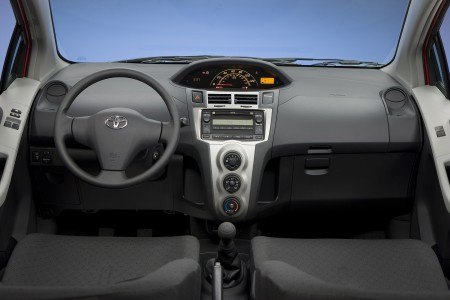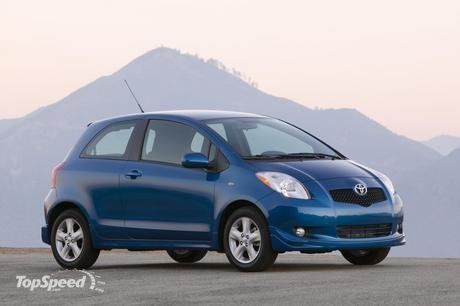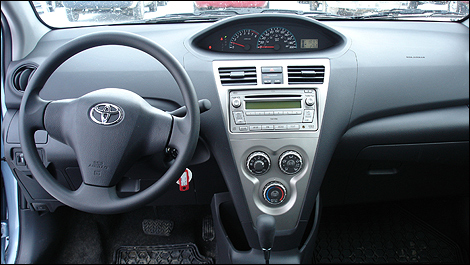As of 2010, the first two generations had achieved in excess of 3.5 million sales in over 70 countries, including more than 1.4 million in Japan.

2009 Toyota Yaris

2009 Toyota Yaris pricing
The first generation XP10 series Toyota Vitz, designed by Sotiris Kovos at Toyota's ED2 studio in Europe. Production began in late 1998, with a Japanese on-sale date of January 1999; European sales commenced two months later as the "Toyota Yaris". When introduced to Australasia in October 1999, the "Toyota Echo" name was used, as was the case in Canada when released there in 2003. The "Echo" and "Yaris" names were also given to the export version of the related Japanese market Toyota Platz sedan, also available as a coupe in North America. Often sold alongside the hatchback and marketed as a single line of vehicles, exterior panels common between the Vitz and Platz were restricted to the front doors. However, as Vitz and Platz were designed using the same platform, the mechanicals are largely identical and both share a common dashboard module. There was also a "Yaris Verso" or "Echo Verso" variant sold in some export markets from late 1999, based on the Japanese "Toyota Fun Cargo". The Verso MPV utilizes the same running gear as the Vitz, but features a more spacious interior.

Toyota Yaris,
What became the XP10 series was shown earlier in concept form at the 1997 Frankfurt Motor Show. This concept, titled "Funtime" was developed under the leadership of Shuhei Toyoda, who also commissioned two additional models based on the same platform: the "Funcoupe" and the "Funcargo", the predecessor to the forthcoming production model Fun Cargo. Styled in Brussels by Toyota's European Office of Creation (EPOC), the "Fun project" as it was known, was envisaged to underline the versatility of shared platform engineering. These concept vehicles morphed into the New Basic Car (NBC) program, with each separate NBC model designated a number, NBC1 in the case of the Vitz three-door. The name Vitz is German for "brilliance" or "wit". Toyota claims the contrived name Yaris is "intended to convey a European impression", while Echo "is intended to Echo nothing."

2009 Toyota Yaris
Instead of conventional analogue instruments, the Vitz utilized digital instruments which were mounted in a "pod" in the center of the dashboard. When sales commenced in the Canadian market this was not the case, with Toyota opting to fit a conventional speedometer, still mounted in the center of the dashboard.

2009 Toyota Yaris Family: New

2009 Toyota Yaris Review
Euro NCAP crash tested the dual-airbag equipped XP10 series in 2000, rating the car 29 out of 37 for adult occupant protection, or four out of five stars. The pedestrian rating (pre-2002) is 13 points or two of out of four stars. In July 2004, ANCAP tested the XP10 with only a driver's airbag fitted, resulting in a 23.64 out of 37 grading, or three out of five stars. The 2010 edition of Monash University's Used Car Safety Ratings (UCSR), found that the XP10 provides a "poor" (two out of five stars) level of occupant safety protection in the event of an accident.

The model will be launched in

Toyota Yaris 2009 3D Model

2009 toyota yaris pricing
The Japanese launch of the Vitz occurred on January 13, 1999, and along with the related Platz, was retailed through the Netz dealership channel.

2009 Toyota Yaris platform

2009 Toyota Yaris Will Release
The Vitz "RS" was introduced in 2001. The "RS" featured revised front and rear bumpers, a mesh grille, black-tinged headlamps, front fog lamps, side skirts, and alloy wheels. Interior upgrades include, sports-oriented front seats, a leather-wrapped steering wheel, a leather and chrome gear shifter, and metallic door sill scuff plates. Two engines were available in the "RS", the 1.3-liter 2NZ-FE and the 1.5-liter 1NZ-FE. More powerful brakes and a firmer suspension calibration were also fitted to the "RS", which was later modified by Toyota Racing Development (TRD) and outfitted with a turbocharger. Produced in limited numbers, the TRD-tuned "RS" produced 120 kilowatts (160 hp) of power and offered a 0–100 kilometres per hour (0–62 mph) time of 7.0 seconds.

2009 toyota yaris

Toyota Yaris 2009 Model

2009-toyota-yaris-hatchback-17

2009 Toyota Yaris Sedan Review

2009 Toyota Yaris Facelift

2009 Toyota Yaris

2009 Toyota Yaris pricing
The first generation XP10 series Toyota Vitz, designed by Sotiris Kovos at Toyota's ED2 studio in Europe. Production began in late 1998, with a Japanese on-sale date of January 1999; European sales commenced two months later as the "Toyota Yaris". When introduced to Australasia in October 1999, the "Toyota Echo" name was used, as was the case in Canada when released there in 2003. The "Echo" and "Yaris" names were also given to the export version of the related Japanese market Toyota Platz sedan, also available as a coupe in North America. Often sold alongside the hatchback and marketed as a single line of vehicles, exterior panels common between the Vitz and Platz were restricted to the front doors. However, as Vitz and Platz were designed using the same platform, the mechanicals are largely identical and both share a common dashboard module. There was also a "Yaris Verso" or "Echo Verso" variant sold in some export markets from late 1999, based on the Japanese "Toyota Fun Cargo". The Verso MPV utilizes the same running gear as the Vitz, but features a more spacious interior.

Toyota Yaris,
What became the XP10 series was shown earlier in concept form at the 1997 Frankfurt Motor Show. This concept, titled "Funtime" was developed under the leadership of Shuhei Toyoda, who also commissioned two additional models based on the same platform: the "Funcoupe" and the "Funcargo", the predecessor to the forthcoming production model Fun Cargo. Styled in Brussels by Toyota's European Office of Creation (EPOC), the "Fun project" as it was known, was envisaged to underline the versatility of shared platform engineering. These concept vehicles morphed into the New Basic Car (NBC) program, with each separate NBC model designated a number, NBC1 in the case of the Vitz three-door. The name Vitz is German for "brilliance" or "wit". Toyota claims the contrived name Yaris is "intended to convey a European impression", while Echo "is intended to Echo nothing."

2009 Toyota Yaris
Instead of conventional analogue instruments, the Vitz utilized digital instruments which were mounted in a "pod" in the center of the dashboard. When sales commenced in the Canadian market this was not the case, with Toyota opting to fit a conventional speedometer, still mounted in the center of the dashboard.

2009 Toyota Yaris Family: New

2009 Toyota Yaris Review
Euro NCAP crash tested the dual-airbag equipped XP10 series in 2000, rating the car 29 out of 37 for adult occupant protection, or four out of five stars. The pedestrian rating (pre-2002) is 13 points or two of out of four stars. In July 2004, ANCAP tested the XP10 with only a driver's airbag fitted, resulting in a 23.64 out of 37 grading, or three out of five stars. The 2010 edition of Monash University's Used Car Safety Ratings (UCSR), found that the XP10 provides a "poor" (two out of five stars) level of occupant safety protection in the event of an accident.
The model will be launched in

Toyota Yaris 2009 3D Model

2009 toyota yaris pricing
The Japanese launch of the Vitz occurred on January 13, 1999, and along with the related Platz, was retailed through the Netz dealership channel.

2009 Toyota Yaris platform

2009 Toyota Yaris Will Release
The Vitz "RS" was introduced in 2001. The "RS" featured revised front and rear bumpers, a mesh grille, black-tinged headlamps, front fog lamps, side skirts, and alloy wheels. Interior upgrades include, sports-oriented front seats, a leather-wrapped steering wheel, a leather and chrome gear shifter, and metallic door sill scuff plates. Two engines were available in the "RS", the 1.3-liter 2NZ-FE and the 1.5-liter 1NZ-FE. More powerful brakes and a firmer suspension calibration were also fitted to the "RS", which was later modified by Toyota Racing Development (TRD) and outfitted with a turbocharger. Produced in limited numbers, the TRD-tuned "RS" produced 120 kilowatts (160 hp) of power and offered a 0–100 kilometres per hour (0–62 mph) time of 7.0 seconds.

2009 toyota yaris

Toyota Yaris 2009 Model

2009-toyota-yaris-hatchback-17

2009 Toyota Yaris Sedan Review

2009 Toyota Yaris Facelift












No comments:
Post a Comment